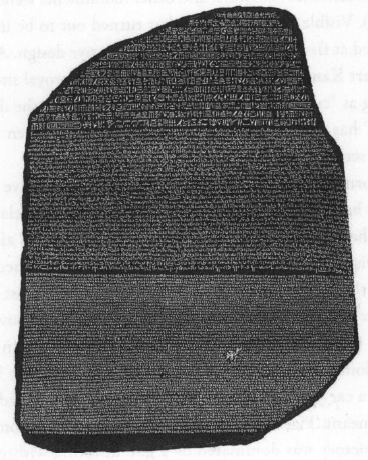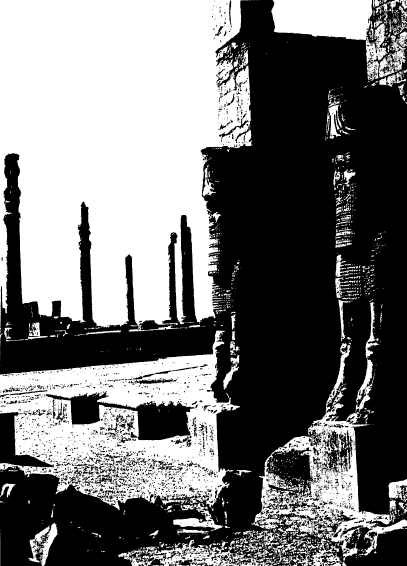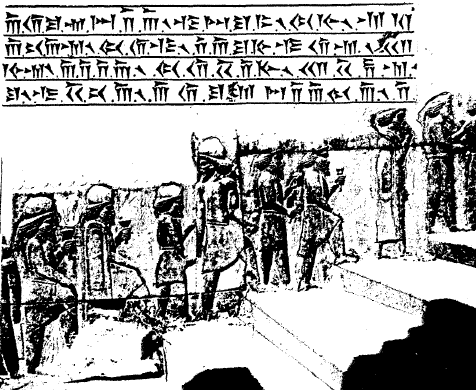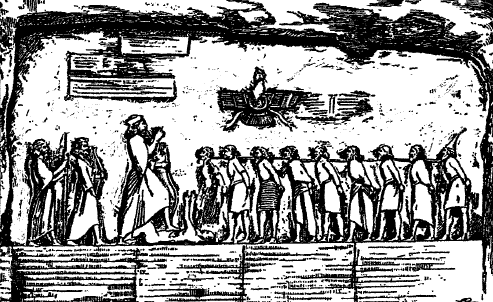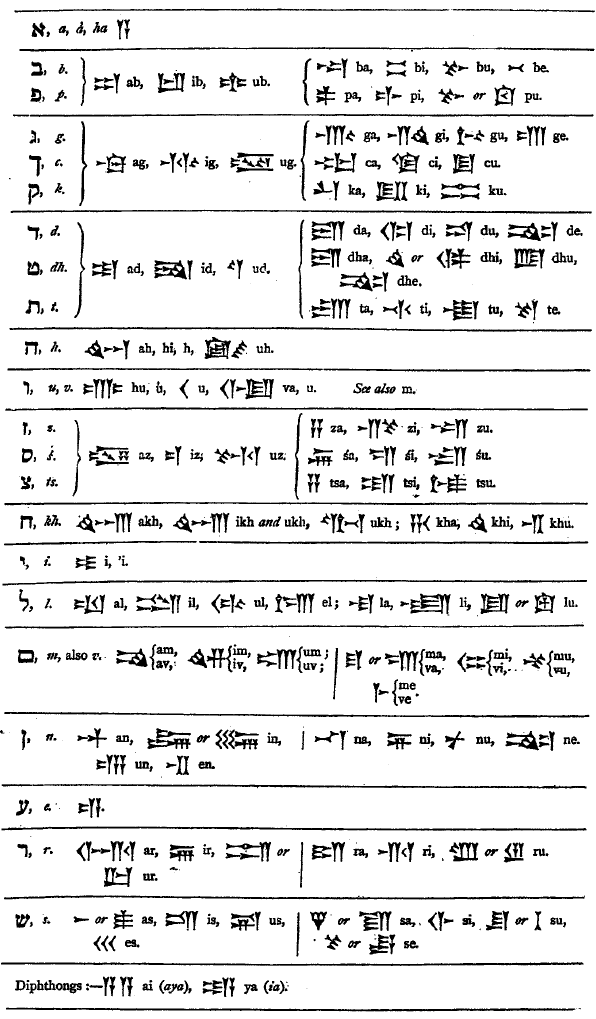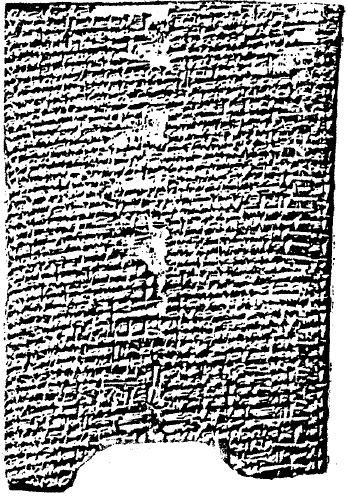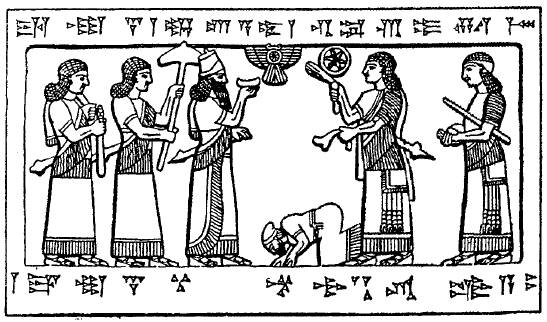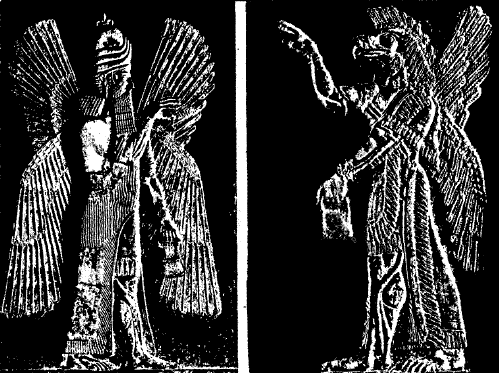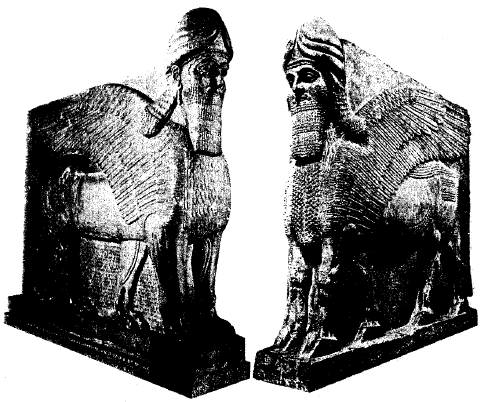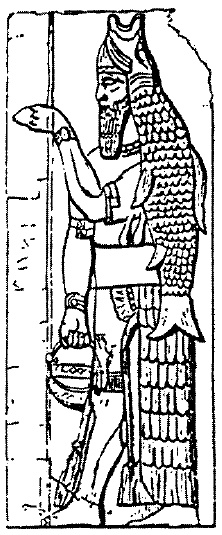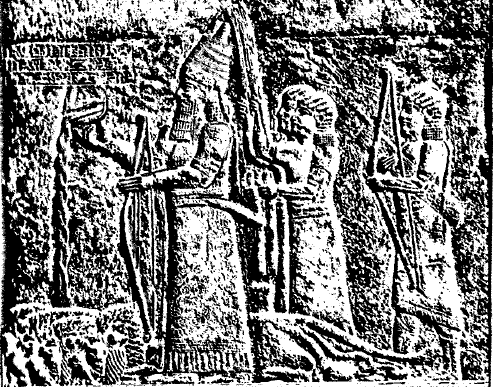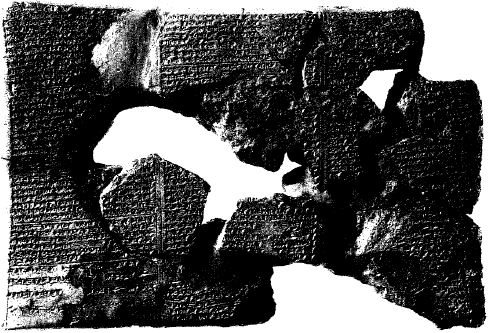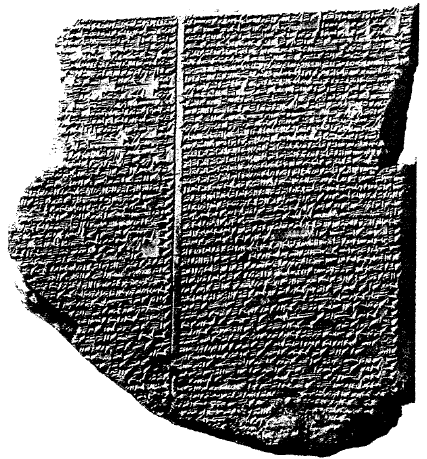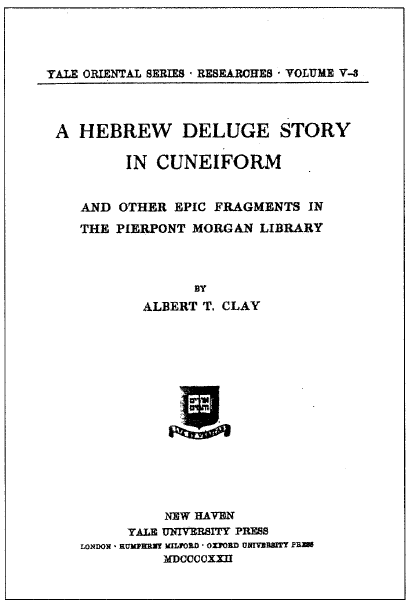|
Ill - In Search of Noah
A 1686 visitor (Engelbert Kampfer) to the ruins of this Persian royal site described the marking as "cuneates" (‘Wedge-Shaped’ - Fig. 16); the designation, ‘Cuneiform’ has stuck ever since to what has in time been recognized as a lingual script.
Disparate reports by travelers increasingly focused attention on some of the multilingual Persian inscriptions; the most important and complex of them was discovered at a site in what is now northern Iran. It was in 1835 that traveling in remote Near Eastern areas that were once dominated by Persian kings, the Briton Henry Rawlinson came across a carving upon forbidding rocks at a place called Behistun.
The name meant ‘Place of gods’, and the huge carving commemorating a royal victory was dominated by a god hovering within the ubiquitous Winged Disc (Fig. 17).
Figure 15
Figure 17 In time it was realized that one of the Behistun languages, dubbed Old Persian, resembled Sanskrit, the ‘Indo-European’ mother language; it was a finding that opened the way to the decipherment of Old Persian.
Taking it from there, the identity and meaning of the other two languages followed. One was later identified as Elamite, whose use in antiquity was limited to the southern parts of what is now Iran. The third matched the writings found in Babylonia; classified as ‘Semitic’, it belonged to a group that also included Assyrian and Canaanite whose mother tongue is called ‘Akkadian’.
What was common to all three Behistun languages was the use of the same cuneiform script, in which each sign expresses a whole syllable and not just a single letter.
Here, in one monument, was an example of the Confusion of Languages... Hebrew, the language of the Bible, belonged to the group of ‘Semitic’ languages that stemmed from ‘Akkadian’.
The fact that Hebrew, uniquely, has remained a spoken, read, and written language throughout the ages was the unlocking key there - so much so that early scholarly studies of Babylonian and Assyrian (two ‘Akkadian’ languages) provided word lists that gave their similar Hebrew meanings, and compared cuneiform sign lists to their equivalents in traditional Hebrew script (Fig. 18 - from Assyrian Grammar by the Rev. A. H. Sayce, 1875).
Figure 18
Then, suggestions that such ruins represented Babylon and Nineveh of biblical fame (and wrath) stirred up a more active interest.
The realization that 19th century A.D. people were able to read inscriptions of people from a time before Greece and Persia, inscriptions from the time of the Bible, shifted interest geographically to the Lands of the Bible and chronologically to much earlier centuries.
Figure 19
Curious what they represented and what they said, European consuls stationed in various parts of the Ottoman empire pioneered what can be considered modern Near Eastern archaeology; its beginning - excavating ancient Babylon - took place south of Baghdad in Iraq in 1811.
(In a twist of fate, clay tablets discovered in the ruins of Babylon included several whose cuneiform inscriptions recorded payments in silver coins by Alexander for work done in clearing debris from the Esagil temple.)
The site was named Kuyunjik after the nearby village; an adjoining Tell was called Nebi Yunus (‘Prophet Jonah’) by the local Arabs.
Botta abandoned the site after his initial probes there were unproductive. Not to be outdone by the French, the Englishman A. Henry Layard took over the site three years later.
The two mounds, where Layard was more successful than Botta, proved to be the ancient Assyrian capital Nineveh that is mentioned repeatedly in the Bible, and that was Jonah’s destination according to the Bible’s tale of Jonah and the Whale.
Not counting Babylon, the finds by both provided, for the first time, physical evidence corroborating the Bible (Genesis, chapter 10) about the hero Nimrod and Assyria and its major cities:
Out of that Land there emanated Ashur, where Nineveh was built - a city of wide streets, and Calah, and Ressen - the great city which is between Nineveh and Calah.
The Bible (2 Kings and in Isaiah) mentions that siege (in which Sennacherib prevailed) as well as his failed siege of Jerusalem. Layard’s finds included a stone column of the Assyrian king Shalmaneser III (858-824 B.C.) that described, in text and carved drawing, his capture of King Jehu of Israel (Fig. 20) - an event reported in the Bible (2 Kings, 2 Chronicles).
Figure 20
By the end of the 19th century, as the rumblings of the conflagration known as World War I became more ominous, the Germans joined the archaeological race (with its mapmaking, spying, and influence-peddling ramifications).
Outflanking the French and the British, they took control of sites farther south, uncovering at Babylon (under the leadership of Robert Koldewey) most of the sacred precinct, the Esagil temple-ziggurat, and the grand Processional Way with its varied gates including that of Ishtar (see Fig. 5).
Farther north Walter Andrae unearthed the olden Assyrian capital Ashur - named ' the same as the land Assyria itself and its national god Ashur (Ressen, which was also mentioned in Genesis and whose name meant ‘Horse’s Bridle’, turned out to have been an Assyrian horse-raising site.)
Wall reliefs in Khorsabad and
Nimrud depicted winged ‘angels’ (Fig. 21) akin to the divine
attendants described in the vision of the Prophet Isaiah (6:2), or
that of the
Prophet Ezekiel’s vision (1:5-8, where each had four
wings but also four faces, one of which was an eagle’s).
Figure 21
In Nineveh and Nimrud, the entrances to the royal palaces were flanked by colossal stone sculptures of human-headed bulls and lions (Fig. 22); and on wall 'reliefs, there were images of divine beings dressed as fish (Fig. 23) - the very image of Oannes, exactly the way Berossus had described him.
The ancient monuments literally corroborated what he had written.
Figure 22
Figure 23
Throughout Mesopotamia - indeed, throughout the ancient Near East - virtually each major urban center had a library as part of either the royal palace, the main temple, or both. By now, thousands upon thousands of clay tablets (or fragments thereof) have been found; most linger, untranslated, in museum and university basements.
Their inscribed texts - all using cuneiform script - ranged from royal annals and records of workers’ rations to commercial contracts and marriage and divorce documents, and included literary texts, historical tales, astronomical data, astrological forecasts, mathematical formulas, word lists, and geographic lists.
Figure 24
And then there were rows of tablets with what the archaeologists classified as ‘mythological texts’ - texts dealing with varied gods, their genealogies, powers, and deeds.
In London, the British Museum engaged a young banknote engraver and amateur ‘Assyriologist’ named George Smith to help sort out cuneiform tablets.
With a keen ability to recognize a particular characteristic of a cuneiform line, he was the first to realize that various fragmented tablets belonged together, forming continuous narratives (Fig. 25).
Figure 25
There was one about a hero and a Flood, another about gods who created Heaven and Earth and also Man.
In a Letter to the Editor about it in a London daily, Smith was the first to draw attention to the similarities between the tales in those tablets and the biblical stories in Genesis.
As it happened, the studies in that direction were led by a succession of scholars not in England but in Germany, where pioneering ‘Assyriologists’ such as Peter Jensen (Kosmologie der Babylonier), Hermann Gunkel (Schdpfung und Chaos), and Friedrich Delitzsch (Das babylonische Weltschdpfungsepos) utilized additional finds by the German archaeologists to form a more coherent text and understand its religious, philosophical, and historical scope.
Pursuing the Creation story line, the Museum’s Curator of Egyptian and Babylonian Antiquities, Leonard W. King, found that a veritable Epic of Creation was in fact inscribed on no less than seven tablets.
His 1902 book, The Seven Tablets of Creation, concluded that a "Standard Text" had existed in Mesopotamia that, like Genesis, told a sequential tale of Creation - from Chaos to a Heaven and an Earth, and then on Earth from the Gathering of the Seas to the Creation of Man - not in the course of the biblical six days plus a day of self-gratification, but over six tablets plus a laudatory seventh.
Tablets from various sites seemed to have identical texts, except in the name by which the Creator Deity was called (the Assyrians called him Ashur, the Babylonians Marduk) - suggesting that they were all renditions adapted from a single canonical version in Akkadian.
However, the occasional retention of some odd words, and names of celestial deities involved in the events - names such as Tiamat and Nudimmud - suggested that such an original version might not have been in Assyrian/Babylonian Akkadian, but in some other unknown language.
Focusing his attention accordingly, the prolific George Smith, poring over thousands of tablet fragments from Nineveh and Nimrud and matching pieces together, announced that they belonged to a full length epic tale about a hero who discovered the secret of the Great Flood.
The three cuneiform signs naming the hero were read by Smith Iz-Du-Bar, and Smith assumed that he was really the biblical Nimrod - the "mighty hunter" who, per Genesis, had started the Assyrian kingdoms - in line with the name of the ancient site, Nimrud, where some of the tablets were found.
Smith himself took up the challenge; he went to Iraq, searched the sites, and returned with 384 new fragmented tablets.
They made possible the piecing together and sequencing of all twelve (!) tablets of the epic tale, including the crucial "Deluge Tablet," Tablet XI (Fig. 26). (As to the prize: It was the Museum that gratefully collected it, claiming that Smith went to Iraq while in its employ...)
But the euphoria was not without problems, among them the variety of gods involved in the event, compared to a sole Yahweh in the Bible. Confounding the scholars, a king named Gilgamesh was nowhere listed as a Babylonian or Assyrian king.
The hero Gilgamesh, scholars found, was identified in the very opening lines on Tablet I as king of Uruk, a city (according to the text) of wide walls and great ramparts.
Figure 26
As the tale was pieced together, it was also realized that Gilgamesh himself was not the hero of the Flood. Being "two-thirds of him divine," his adventures were in search of immortality; and it was in the course of that search that he heard the tale of the Flood from one called Utnapishtim - a Mesopotamian ‘Noah’ who had actually survived the catastrophe.
So who was Gilgamesh - scholars and press wondered - if he was neither the biblical Noah nor the biblical/Assyrian Nimrod?
It was the first book to announce and compare the ancient texts discovered in Mesopotamia with the Creation and Deluge tales in the Bible. It was also Smith’s last book: He died that same year, at the young age of 36; but it ought to be remembered that it was the ingenuity and findings of this self-taught master of Akkadian that served as the foundation for the subsequent myriad studies.
This is Noah himself speaking!
In the course of piecing together the text’s three tablets, a tablet-fragment marked "S" was essential for identifying the name Atra-Hasis; the "S" stood for Smith; it was he who, before he died, had found the key to another amazing ‘Babylonian’ tale of gods, Man, and Deluge.
As to the hero’s name, it has been suggested, with little doubt, that Atra-Hasis, transposed as Hasis-atra, was the Xisithros/Sisithros in the Berossus Fragments - the tenth pre-Diluvial ruler in whose time the Deluge had occurred, just as Noah was the tenth biblical ancestor in the line of Adam!
This was an incredible time-bridging of at least 2,600 years; but that too proved to be just an interim way station on the march back in history.
It too contained unfamiliar words and names, certainly not of Semitic-Akkadian provenance - gods named Enlil, Enki and Ninurta, goddesses named Ninti and Nisaba, divine groups called Anunnaki and Igigi, a sacred place named Ekur. Where have they all come from?
Fortunately, preserved in each one was the scribal statement giving his name, title, and date of completing the tablet (as this one at the end of the first tablet):
Tablets II and III were likewise signed by the same scribe and were also dated to a particular year in the reign of King Ammi-Saduka.
It was not an unknown royal name: Ammi-Saduka belonged to the famed Hammurabi dynasty of Babylon; he reigned there from 1647 to 1625 B.C. Thus, this Babylonian version of the Noah/Deluge tale was a thousand years older than AshurbanipaVs Assyrian version.
And it too was a copy - of what original? The incredulous scholars had the answers right in front of them.
On one of his tablets Ashurbanipal boasted thus:
Apart from disclosing the existence of a "god of scribes," here was a confirmation by an independent source, centuries before Berossus, of the occurrence of the Deluge, plus the detail that there had been "enigmatic words," preserved in stone carvings "from the days before the Flood" - a statement that matches and corroborates the Berossus assertion that the god Cronos,
And then there is the prideful boast in the Ashurbanipal statement that he,
Shumeriarit The puzzled scholars - who had managed to decipher Babylonian, Assyrian, Old Persian, Sanskrit - wondered what Ashurbanipal was talking about. The answer, it was realized, had been provided by the Bible all along.
Hitherto, the verses in Genesis 10:8-12 about the domains of the mighty hero Nimrod had inspired the decipherers of those ancient languages to name the mother tongue of Babylonian and Assyrian Akkadian’, and served as a Discoverers’ Map for the excavating archaeologists; now these verses also clarified the Shumerian mystery:
Sumer (or more correctly, Shumer), was the biblical Shine’ar - the very land whose settlers after the Deluge attempted to build a tower whose head could reach the heavens.
But which land, and where, had it been?
In fact, the Bible (Genesis 7:11-12) states that the Deluge began when,
It was only after that (or as a result thereof) that,
The Deluge ended in likewise sequence (Genesis 8:2-3), when first "the water sources of the Great Deep," and then "the sluices of the sky," shut down.
The Akkadian version (Gilgamesh Tablet XI) states that the first manifestation of the Deluge was,
In the Sumerian tale of the Deluge, howling winds are mentioned; rain is not:
In Twelfth Planet and subsequent books, I have suggested that "the Great Deep," where the "South Storm" originated, was Antarctica; and that the Deluge was a huge tidal wave caused by the slippage of the ice sheet off Antarctica - causing the abrupt end of the last Ice Age circa 13,000 years ago. (See also Fig. 43.)
|
